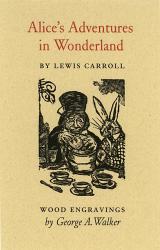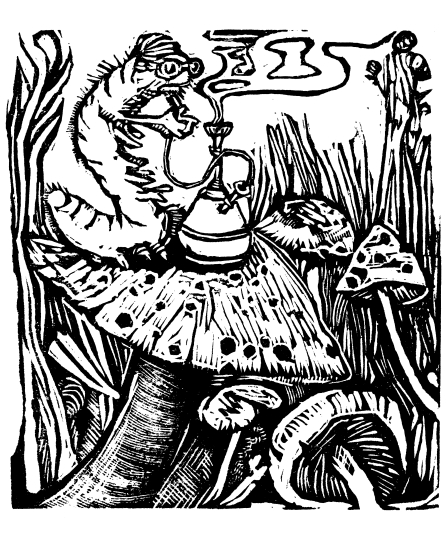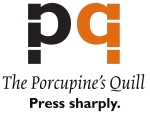
Lewis Carroll’s beloved children’s classic comes to life with over one hundred whimsical, eccentric and darkly humorous wood engravings, all created by the ‘Mad Hatter’ of Canadian graphic arts himself, the award-winning George A. Walker.
About the Book

In 1980, George A. Walker was all of nineteen years old and starting his first year at the Ontario College of Art when printmaking instructor Bill Poole approached him with a crazy idea: to create ninety-six wood engravings for Poole’s limited, letterpress edition of Alice’s Adventures in Wonderland. The project took ten years to complete and only 177 volumes were ever made. It was the very first entirely Canadian publication of Carroll’s beloved classic.
Now Walker is an internationally acclaimed artist and the Porcupine’s Quill has finally made this unique artwork, alongside the book that inspired it, widely available to layreaders -- this time with several extra illustrations not present in the earlier edition. Walker’s engravings are as playful, surreal and downright provocative as ever, offering a new and darkly energetic interpretation of Carroll’s masterpiece and subtly toying with Sir John Tenniel’s famous nineteenth-century illustrations.
Wood engraving is a meticulous, delicate art form with a history spanning hundreds of years, and Walker works in the same tradition as Tenniel himself whose illustrations were made into wood cuts by the Dalziel brothers for the first printing of Alice’s Adventures in Wonderland in 1865. This 2011 edition celebrates Alice’s spectacular adventures as well as her equally spectacular artistic heritage with a uniquely modern twist -- by the man now known as the ‘Mad Hatter’ of Canadian graphic arts.
Praise for Alice's Adventures in Wonderland
‘It takes hubris to reinterpret artist John Tenniel’s original vision of Alice’s journey. Enter the so-called ‘‘Mad Hatter of Canadian Graphic Arts,’’ engraver George Walker, who began the project as a student twenty years ago. Tender and dark at the same time, these extraordinary woodcuts reflect their maker’s youthful energy. An introduction by Alberto Manguel says it best: ‘‘Glimpses, snapshots, details of larger scenes tell of Walker’s reading, a reading that follows Alice’s frantic pace, far from Victorian sobriety, from madness to greater madness.’’ Both Alice’s story and these remarkable illustrations communicate on many levels. Ages nine to twelve.’
—ForeWord Magazine
‘Walker is an artist of many talents and media -- and many contradictions. A figurative artist, he is interested in illuminating abstractions cast up from his unconscious. Literate and articulate, he expresses complex thoughts and ideas in singular images. He published a book without text, letting the images carry the narrative. A generous nature can give way suddenly to a disquisition on social inequality that he also translates into the grammar of picture making. There is a startling muteness and directness to his pictures, yet they are intended to effect change, often in the immediate world around him, or in the viewer’s perceptions of the world around them. The technical dimension of his artistic practice is privileged and apparent in the work, yet the art far exceeds material, method and process. His art is often grounded in the process of automatism, allowing for the unconscious to speak directly and spontaneously in images, even as his technique embraces the painstaking and precise nomenclature of wood engraving, block printing and bookbinding. The immediacy of his messages and their meanings are the product of careful rendering, circumspection and consideration.
—Tom Smart, Devil’s Artisan
The Porcupine’s Quill has just released a wonderful new edition of Alice in Wonderland lavishly illustrated with wood engravings by George Walker and with a new introduction by Alberto Manguel. Following in the tradition of the Cheshire Cat Press edition published nearly 25 years ago by Bill Poole, George Walker and Joseph Brabant (one of the finest examples of a Canadian private press book), the story is as beautiful woven through the illustrations and design as it is through the magical words we are all familiar with.
—Richard, Bytown Bookshop
Walker’s edition of Alice’s Adventures in Wonderland (Cheshire Cat Press, 1988) announced forcefully his precocious talents as a printmaker and book artist. His enormously expressive woodcut illustrations paired with master letterpress publisher Bill Poole’s sensitive handling of type, printing and binding, comprised one of the finest hand-printed volumes ever produced in Canada. Alice has just been issued in a trade edition paperback by Porcupine’s Quill in Erin, Ont.
—Tom Smart, "The great Canadian (graphic) novel", Telegraph-Journal
‘The classic Alice in Wonderland is known by all, but the story is off the wall enough that one’s interpretation may be different from another’s. Alice Adventure’s in Wonderland: Wood Engravings is George A. Walker’s own take with woodcuts as he illustrates Carroll’s famed story. Showing a unique skill in his interpretation, he captures a charm that’s been lost with the decline of woodcuts, and makes for a unique journey. Alice’s Adventure in Wonderland is a must for any fan of the story and unique art styles.’
—Midwest Book Review
‘The delicacy and intelligence of George Walker’s print-making seems to have come to us from a bygone age. Fortunately, we have George with us now.’
—Neil Gaiman
Read an Excerpt
From the Introduction
By Joseph A. Brabant
On the 27th of January, 1983, Bill Poole, George Walker and I met for lunch at Chives on Queen Street in Toronto. Bin is the kind of chap who remembers birthdays and he was quick to remind us that it was Lewis Carroll’s 151st birthday. We got to talking about Carroll and by the time lunch was over we had decided to publish an edition of Alice’s Adventures In Wonderland. George would do the illustrations; Bill would print the book; and I would be the editor.
We then went about our appointed tasks, meeting for lunch about once a month for the next five years to review our progress with the book. There were always two or three pages of freshly printed text to proofread; we would discuss where the illustrations should be placed; and our waitresses soon got used to serving lunch on tables piled high with wood engravings, sketches, books and pageproofs.
George cut more than one hundred and fifty wood engravings. At times two or three engravings competed for the same space on a page and some hard choices had to be made. Ninety-six were eventually used. One interesting feature of the book is that George tried, as often as possible, to depict episodes which had seldom or never been illustrated before, like Elsie, Lacie and Tihie at the bottom of the treacle well in the Dormouse’s story.
My task was to decide which of the variant texts of the book we would print, and I finally settled on the text as it read in copies printed in 1897 just before Carroll’s death. These copies known as the eighty-sixth thousand copies were the last ones printed under Carroll’s supervision. We followed the 1897 text faithfully and readers interested in such details will note, for instance, that the words ‘salt water’ are unhyphenated at page 16, there is no bracket after the declension of ‘mouse’ at page 12, and there are missing quotation marks at page 57 when the King is talking to Alice about the Cheshire Cat. We also retained Carroll’s idiosyncratic spelling of words like ‘sha’n’t’ and ‘ca’n’t’. Bill set the type by hand and in the course of doing so he noted that Carroll had a predilection for words with the letter ‘t’. (We offer no explanations, Freudian or otherwise.) Bill also did all the printing by hand with all the risks which that entails. Somewhere there is a letter ‘f’ with a partly broken stem; it broke during the printing as the heavy press slammed down once more. Bill noticed it much later but will not say where! He printed the illustrations directly from George’s wood engravings, unlike Carroll’s printers who did not use Tenniel’s woodblocks but worked instead with devices like electrotypes taken from the woodblocks.
Thus was the tale of Wonderland retold once again. Retold, by the way, for the first time in Canada. We hope the reader will like it.
[Continued in Alice's Adventures in Wonderland
About the Author

Lewis Carroll was born on the 27th of January, 1832, as Charles Lutwidge Dogson at Daresbury in Cheshire, England. Carroll is best known for his children’s books Alice’s Adventures in Wonderland and Through the Looking-Glass, which quickly became international successes and to this day inspire films, art, and research. Other famous works of his are the poems ‘The Hunting of the Snark’ and ‘Jabberwocky’. Carroll had a prodigious talent in mathematics, logics, word play and philosophy, and he spent most of his life teaching mathematics at Christ Church, Oxford. He died at the age of sixty-five on January 14th, 1898, in Surrey, England. Today there are societies around the world dedicated to the study of his life and appreciation of his writings.
About the Artist

George A. Walker (Canadian, b. 1960) is an award-winning wood engraver, book artist, teacher, author, and illustrator who has been creating artwork and books and publishing at his private press since 1984. Walker’s popular courses in book arts and printmaking at the OCAD University in Toronto, where he is Associate Professor, have been running continuously since 1985. For over twenty years Walker has exhibited his wood engravings and limited edition books internationally, often in conjunction with The Loving Society of Letterpress (and The Binders of Infinite Love) and the Canadian Bookbinders and Book Artists Guild (CBBAG). Among many book projects Walker has illustrated two hand-printed books written by author Neil Gaiman. Walker also is the illustrator of the first Canadian editions of Lewis Carroll’s Alice’s Adventures In Wonderland and Alice Through the Looking-Glass books (Cheshire Cat Press). George A. Walker was elected to the Royal Canadian Academy of Art for his contribution to the cultural area of Book Arts.
